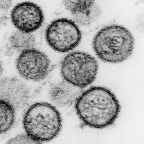|
Hantavirus
This is a genus of viruses that are carried by mice, rats, and voles. The first virus in this group was isolated in 1976. During the Korean War this virus caused a bleeding disease known as Korean hemorrhagic fever. The virus was named Hantaan virus after the Han River in South Korea. It infected about 2,500 U.S. troops and killed about 5% to 10% of them. There is potential for it to be used as a biological weapon in the future.
After this incident in the Korean War, the virus has virtually gone unnoticed until 1993. A new outbreak occurred in the Four Corners region of southwestern U.S. that was blamed for the death of 32 people out 53 infected people. This outbreak was covered by the press who focused on the young or Navajo Indians who suffocated from damaged blood vessels in the lungs. A month later, the CDC identified the new virus and called it Muerta Canyon virus after a canyon near the Navajo reservation. The Navajos didn't like this since they didn't want the Canyon associated with a virus. Thus, it was renamed Sin Nombre, which means "no name" in Spanish.
The sin nombre virus is up to ten times more deadly than the Hantaan virus from the Korean War. No one knows how long this virus have been around. Navajo medicine men have reported outbreaks of this disease during deer mouse infestations, which is how the virus spreads, in 1918 and 1933. It has even become part of legends. Navajo Indians would burn cloth soiled by mice.

|
|
| .. Next page |